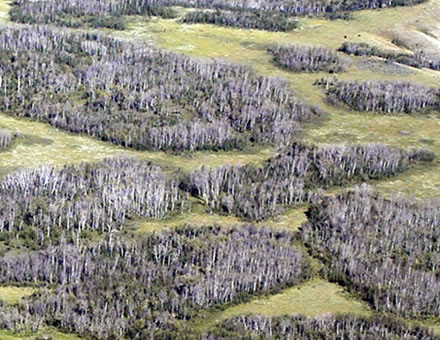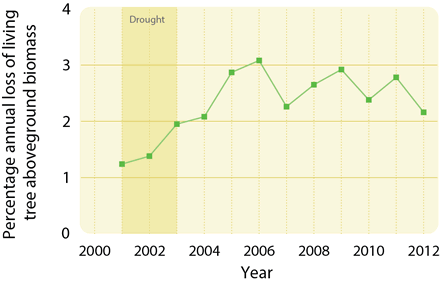Tree mortality is increasing worldwide, including Canada.
Tree mortality refers to the death of forest trees and provides a measure of forest health. The premature death of healthy trees may be caused by drought and other extreme weather events, or by climate-triggered outbreaks of insect pests in weakened forests. A widespread increase in tree mortality has been reported in many forest types in Canada and around the world over the past few decades. A severe drought in 2001–2002 led to the dieback and decline of aspen forests across large areas of western North America. Although tree mortality is hard to project, it is expected to continue to increase with continued climate change, particularly in areas where extreme weather events, such as severe drought, become more frequent. Increased tree mortality has impacts on forest ecosystem functioning, timber supply and carbon balance.
Why tree mortality is important
Tree mortality provides a measure of forest health and affects carbon balance.
Climate-related disturbances such as drought can lead to the premature death of healthy trees that are important to forest ecosystem functioning and wood supply for the forest industry. Tree mortality can emerge abruptly at a regional scale when climate conditions exceed species-specific physiological thresholds or if climate triggers associated outbreaks of insect pests in weakened forests.
Changes in tree mortality may affect forest age structure. Differences in tree mortality between species result in changes in forest composition. Increases in tree mortality also have impacts on local, regional and global carbon budgets: living trees take up CO2 through the process of photosynthesis, while dead trees release CO2 when they fall and decay on the forest floor.
Tracking the effects of climate change on tree mortality provides information on broad-scale die-back processes that have impacts on forest ecology and the forest sector.
What has changed
Tree mortality in many forest types has increased in recent decades and has been attributed to climate change.
A widespread increase in tree mortality has been reported in many forest types in Canada and around the world over the past few decades. Large-scale mortality episodes and forest decline have occurred following significant drought and heat waves, often in combination with outbreaks of insects and diseases. However, the interaction between climatic variation and forest ecological processes are complex, and it is difficult to determine whether climate change was the main cause of increasing tree mortality.
A severe drought in 2001–2002 led to the dieback and decline of aspen forests across large areas of western North America, including the aspen parklands of Saskatchewan and Alberta (Figure 1).

The 2001-2002 drought resulted in widespread aspen mortality in western Canada

Figure 1 – Trends (2001-2012) in aspen mortality (in percentage of annual loss of aboveground biomass) across a network of 24 study sites in western Canada (Climate impacts on productivity and health of aspen, CIPHA), following the severe 2001-2002 drought
Larger image [25 Kb]
Graph data
| Year | Mortality |
|---|---|
| 2001 | 1.24 |
| 2002 | 1.38 |
| 2003 | 1.95 |
| 2004 | 2.08 |
| 2005 | 2.87 |
| 2006 | 3.08 |
| 2007 | 2.26 |
| 2008 | 2.65 |
| 2009 | 2.92 |
| 2010 | 2.38 |
| 2011 | 2.78 |
| 2012 | 2.16 |
The outlook
Tree mortality will likely increase in areas where extreme weather events become more frequent.
Climate change projections indicate that in some parts of Canada, droughts and other extreme events are expected to become more frequent in the future. These changes could trigger increases in tree mortality and episodes of forest decline in affected areas, posing challenges for forest management and the long-term supply of forest resources and services, including carbon balance.
How tree mortality and its indicators are defined
Tree mortality refers to the death of forest trees that is not the result of harvesting. The attribution of tree mortality to climate change is difficult. The death of trees often has multiple causes and is highly episodic and patchy, posing challenges for tracking and determining causation.
For this project, tree mortality is estimated using the percentage of annual loss of living tree aboveground biomass in repeated observations within long-term plots established by government agencies and forest companies... Within each plot, every tree is marked and georeferenced. Observations include the status (dead/live) and the diameter (at 1.3-metre height) of each tree. Living tree biomass is estimated by applying mathematical equations that use measurements of tree stem diameter and total tree height (see: Canadian national tree aboveground biomass equations). Tree death due to major disturbances such as fire or harvesting is excluded.
Sources and references for tree mortality and its indicators
- Allen, C.D., et al. 2010. A global overview of drought and heat-induced tree mortality reveals emerging climate change risks for forests. Forest Ecology and Management 259, 660–684.
- Anderegg, W.R., Kane, J.M., et al. 2013. Consequences of widespread tree mortality triggered by drought and temperature stress. Nature Climate Change 3, 30–36.
- Hogg, E.H., Brandt, J.P., et al. 2008. Impacts of a regional drought on the productivity, dieback and biomass of western Canadian aspen forests. Canadian Journal of Forest Research 38, 1373–1384.
- Holzwarth, F., Kahl, A., et al. 2013. Many ways to die: Partitioning tree mortality dynamics in a near-natural mixed deciduous forest. Journal of Ecology 101, 220–230.
- Jones, C., Lowe, J., et al. 2009. Committed terrestrial ecosystem changes due to climate change. Nature Geoscience 2, 484–487.
- Lambert, M.-C., Ung, C.-H., et al. 2005. Canadian national tree aboveground biomass equations [1.18 Mb PDF]. Canadian Journal of Forest Research 35, 1996–2018.
- Luo, Y., and Chen, H.Y.H. 2011. Competition, species interaction, and ageing control tree mortality in boreal forests. Journal of Ecology 99, 1470–1480.
- Luo, Y., and Chen, H.Y.H. 2013. Observations from old forests underestimate climate change effects on tree mortality. Nature Communications 4, 1655.
- Michaelian, M., Hogg, E.H., et al. 2011. Massive mortality of aspen following severe drought along the southern edge of the Canadian boreal forest. Global Change Biology 17, 2084–2094.
- Peng, C., Ma, Z., et al. 2011. A drought-induced pervasive increase in tree mortality across Canada’s boreal forests. Nature Climate Change 1, 467–471.
- Thorpe, H.C., and Daniels, L.D. 2012. Long-term trends in tree mortality rates in the Alberta foothills are driven by stand development. Canadian Journal of Forest Research 42, 1687–1696.
- van Mantgem, P.J., Stephenson, N.L., et al. 2009. Widespread increase of tree mortality rates in the western United States. Science 323, 521–524.
- Worrall, J.J., Rehfeldt, G.E., et al. 2013. Recent declines of Populus tremuloides in North America linked to climate. Forest Ecology and Management 299, 35–51.
Canadian Forest Service key contacts
Ted Hogg, Research Scientist, Vegetation Climate Interactions, Northern Forestry Centre
Michael Michaelian, Forest Health Technician, Northern Forestry Centre
Adaptation tools and resources
Assisted migration of tree species in Canada – a web page describing the human-assisted movement of plants to more climatically suitable habitats and links to articles, reports and resources
Adaptation Options – an inventory of adaptation options proposed in the literature for the managed boreal forest
Forest Change Toolkit – a list of tools and resources for climate change adaptation
- Hogg, E.H., Brandt, J.P., et al. 2008. Impacts of a regional drought on the productivity, dieback and biomass of western Canadian aspen forests. Canadian Journal of Forest Research 38, 1373–1384.
- Hogg, E.H., Barr, A.G., et al. 2013. A simple Soil Moisture Index for representing multi-year drought impacts on aspen productivity in the western Canadian interior. Agricultural and Forest Meteorology 178–179, 173–182.
- Kurz, W.A., Dymond, C.C., et al. 2008. Mountain pine beetle and forest carbon feedback to climate change. Nature 452(7190), 987–990.
- Lambert, M.-C., Ung, C.-H., et al. 2005. Canadian national tree aboveground biomass equations. Canadian Journal of Forest Research 35, 1996–2018.
- Michaelian, M., Hogg, E.H., et al. 2011. Massive mortality of aspen following severe drought along the southern edge of the Canadian boreal forest. Global Change Biology 17, 2084–2094.
- Michaelian, M. 2015. Factors affecting fall down rates of dead aspen (Populus tremuloides) biomass following severe drought in west-central Canada. Global Change Biology 21, 1968–1979.
- Peng, C., Ma, Z., et al. 2011. A drought-induced pervasive increase in tree mortality across Canada's boreal forests. Nature Climate Change 1, 467–471.
- Wang, Y., Hogg, E.H., et al. 2014. Past and projected future changes in moisture conditions in the Canadian boreal forest. Forestry Chronicle 90, 678–691.